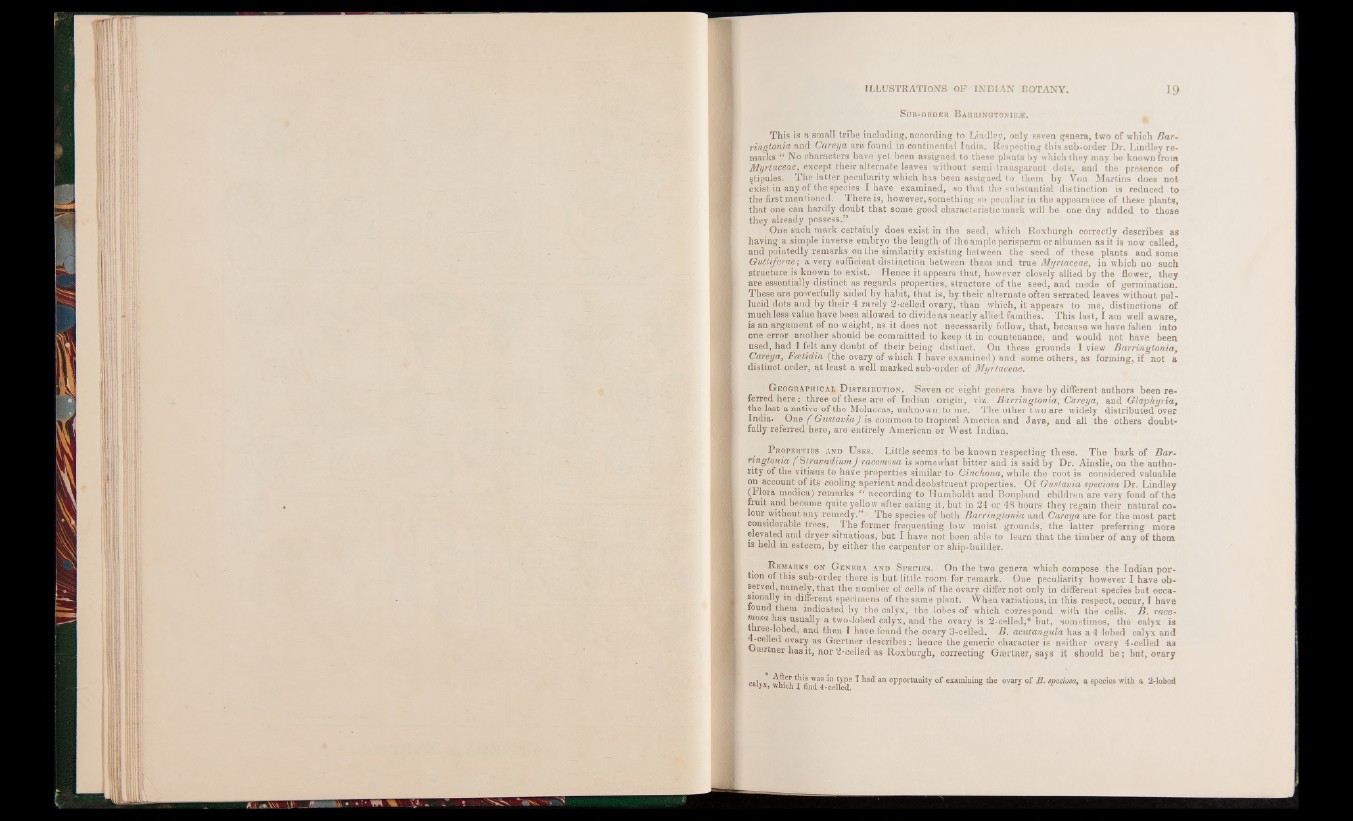
SüB-ORDËR BARRINGTONIEÆ.
This is a small tribe including, according to Lindley, only seven genera, two of which Bar-
ringtonia and Careya are found in continental India. Respecting this sub-order Dr. Lindley remarks
“ No characters have yet been assigned to these plants by which they may be known from
Myrtaceae, except their alternate leaves without semi-transparent dots, and the presence of
gtipules. The latter peculiarity which has been assigned to them by Von Martins does not
exist in any of the species I have examined, so that the substantial distinction is reduced to
the first mentioned. There is, however, something so peculiar in the appearance of these plants,
that one can hardly doubt that some good characteristic mark will be one day added to those
they already possess.’*
One such mark certainly does exist in the seed, which Roxburgh correctly describes as
having a simple inverse embryo the length of the ample perisperm or albumen as it is now called,
and pointedly remarks on the similarity existing between the seed of these plants and some
Gutliferae; a very sufficient distinction between them and true Myrtaceae, in which no such
structure is known to exist. Hence it appears that, however closely allied by the flower, they
are essentially distinct as regards properties, structure of the seed, and mode of germination.
These are powerfully aided by habit, that is, by their alternate often serrated leaves without pellucid
dots and by their 4 rarely 2-celled ovary, than which, it appears to me, distinctions of
much less value have been allowed to divide as nearly allied families. This last, I am well aware,
is an argument of no weight, as it does not necessarily follow, that, because we have fallen into
one error another should be committed to keep it in countenance, and would not have been
used, had I felt any doubt of their being distinct. On these grounds I view Bar ringtonia,
Careya, Fcetidia (the ovary of which I have examined) and some others, as forming, if not a
distinct order, at least a well marked sub-order of Myrtaceae.
G eographical D istribution. Seven or eight genera have by different authors been referred
here : three of these are of Indian origin, viz. Bar ringtonia, Careya, and Glaphyria,
the last a native of the Moluccas, unknown, to me. The other two are widely distributed over
India. One (Gustavia) is common to tropical America and Java, and all the others doubtfully
referred here, are entirely American or West Indian.
P roperties a n d U ses. Little seems to be known respecting these. The bark o f Bar-
ringtonia ( htravadiumJ racemosa is somewhat bitter and is said by Dr. Ainslie, on the authority
of the vitians to have properties similar to Cinchona, while the root is considered valuable
on account of its cooling aperient and deobstruent properties. Of Gustavia speciosa Dr. Lindley
(Flora medica) remarks “ according to H umboldt and Bonpland children are very fond o f the
fruit and become quite yellow after eating it, but in 24 or 48 hours they regain their natural colour
without any remedy.” The species of both Barringtonia and Careya are for the most part
considerable trees. The former frequenting low moist grounds, the latter preferring more
elevated and dryer situations, but I have not been able to learn that the timber o f any o f them
is held in esteem, by either the carpenter or ship-builder.
. R emarks on G enera and S pec ies. On the two genera which compose the Indian portion
of this sub-order there is but little room for remark. One peculiarity however I have observed,
namely, that the number of cells of the ovary differ not only in different species but occasionally
in different specimens of the same plant. When variations, in this respect, occur, 1 have
round them indicated by the calyx, the lobes of which correspond with the cells. B. race-
«wsa has usually a two-lobed calyx, and the ovary is 2-celled,* but, sometimes, the calyx is
three-lobed, and then I have found the ovary 3-celled. B. acutangula has a 4 lobed calyx and
-celled ovary as Gsertner describes : hence the generic character is neither ovary 4-celled a3
ffirtner has it, nor 2-celled as Roxburgh, correcting Gsertner, says it should b e ; but, ovary
caj^x *n tyPe I had an opportunity of examining the ovary of B. speciosa, a species with a 2-lobed